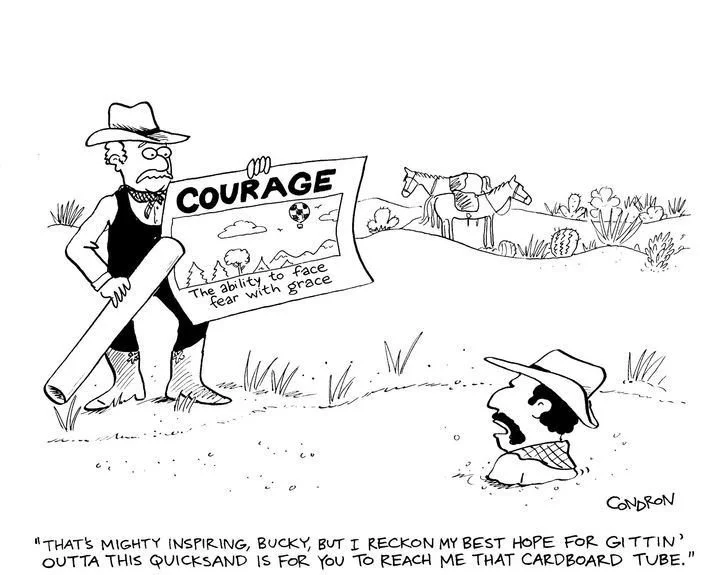Finding the Stretch Zone
Discomfort can be confusing because it often feels like a sign that something is wrong, even though it is usually a normal part of trying something new. Real progress begins when we are willing to stretch beyond what feels comfortable.
Stretch is the space between what is familiar and what feels overwhelming. This is where you are challenged just enough to learn, adapt, and grow without shutting down. Leading in the Stretch Zone means leaning into discomfort with clear intent, choosing challenges that build capability rather than simply enduring pressure.
Our brains are naturally wired to seek safety and predictability. But staying in familiar routines too long limits our adaptability, creativity, and leadership potential. Uncertainty can be a signal, not a warning. It tells us we are trying, learning, and stepping into something that matters.
This session is about learning to recognize that signal and respond to it in a way that supports thoughtful growth. You will explore what it looks like to operate in your stretch zone (rather than your panic zone) and how to help others do the same. What matters most is continuing forward with curiosity and effort.
Self-Assessment: Finding the Stretch Zone
Please take a few moments to contemplate the following self-reflection questions. Where can you identify opportunities for personal growth in your leadership?
How do I typically respond when something feels unfamiliar or uncomfortable?
Do I tend to stay in my comfort zone, push too far, or find a balanced stretch?
What emotions come up for me when I feel challenged or unsure?
When was the last time I chose to step into discomfort for the sake of growth?
Do I create space for learning through mistakes, or do I expect people to get it right the first time?
How do I know the difference between healthy discomfort and unhelpful pressure, both for myself and those I lead?
What supports help me stay grounded when I am stretching myself beyond what feels natural?
How do I support others when they are outside their comfort zone and still building confidence?
Remember, this self-assessment is just a starting point for understanding your knowledge of The Stretch Zone as a leader. It's essential to reflect on your responses and actively work on areas where improvement is needed. Additionally, working with your ECFL Leadership Coach or seeking feedback from a trusted mentor can provide valuable insights into your strengths and weaknesses.
“A ship in harbor is safe, but that is not what ships are built for.”
Stretching means stepping into something new with a mindset that welcomes learning. You take on just enough challenge to grow without feeling overwhelmed, and progress comes from trying, adjusting, and learning as you go.
This happens within three distinct zones:
The Comfort Zone: This is where things feel familiar and safe. Tasks are known, and efficiency may be high, but growth tends to be limited.
The Stretch Zone: Here, people are challenged in ways that push their thinking and expand their skills. Discomfort is present, but it stays manageable.
The Panic Zone: This is where the challenge feels too intense. Stress can take over, performance declines, and learning often stops.
Effective leaders recognize the value of working in the Stretch Zone. They know that this is where people build confidence, solve problems creatively, and strengthen their ability to adapt. Their job is to support people through the discomfort without removing the challenge entirely.
Your approach makes a difference. When you give yourself permission to learn through effort instead of expecting perfection, you open the door to curiosity. Taking small, thoughtful risks and allowing space for mistakes are all part of the learning process.
It also helps to notice what kind of feelings you are experiencing. Not every difficult moment is dangerous. Some are simply unfamiliar. Becoming more aware of your own reactions allows you to respond with clarity and lead with intention.
Here's what it looks like when someone chooses to step into their Stretch Zone.
Cal-culating Your Stretch Zone
Cal C. Um had been a steady presence at the plant for years. He knew the work, knew his team, and had earned the respect that comes with consistency. What he did not have was experience leading meetings, especially not in front of upper management. So when his supervisor asked him to run the next weekly safety briefing, Cal felt his stomach drop.
His first instinct was to say no. He told himself he wasn't "the presentation type," and that someone else would do a better job. But later that night, he thought about something he often said to new hires: "If you never try, you never grow." The words stuck.
The next day, Cal agreed to do it. He didn't try to sound like someone else. He kept the safety notes simple, shared a story about a near-miss from a previous project, and made space for the team to ask questions. It wasn't flashy, but it was honest. And the team listened.
Afterward, a few people thanked him for how clear and relatable it was. One crew member said it was the first time they really understood why the lockout procedure mattered. Cal was surprised by how good that felt.
It wasn't easy. It wasn't perfect. But it was a stretch… and it stuck with him. From that point on, Cal didn't shy away from unfamiliar opportunities. He just took them one step at a time.
“You have been assigned this mountain so that you can show others it can be moved.”
Notice that Cal didn't wait until he felt ready. He felt the panic, paused, and chose to continue anyway. The next time you feel your heart race before a challenge, remember: that discomfort might be your signal to lean in, not pull back.
Discomfort often signals growth rather than failure, but recognizing that signal is only the first step. Staying in the stretch zone long enough to learn requires self-awareness, intentional habits, and actionable tools. The best leaders prepare for discomfort by understanding what it looks like in themselves and their teams, then creating environments where stretching feels possible and supported. Below are some practical ways to help yourself and others stay grounded, curious, and confident in the stretch zone.
Best Practices for Finding the Stretch Zone
Recognize the Difference Between Fear and Danger: Not every hard thing is harmful. Fear of failure often comes from uncertainty rather than actual danger. When you feel resistance, stop and ask yourself whether you are facing real risk or simply the discomfort of growth.
Stretching often feels uncertain, but that doesn’t mean it is unsafe. When you feel fear, pause and ask: "Is this discomfort because I am growing, or is it something I truly need to avoid?"
Take Smart, Manageable Risks: Stretching does not mean taking on everything at once. It means identifying one step that feels just beyond your comfort zone and choosing to act on it. Challenge yourself to move forward even if you are not completely sure.
Building on last session’s mindset: take the next best step, not the perfect one!
Interrupt Negative Thought Patterns About Discomfort: When discomfort arises, the brain often jumps to worst-case scenarios. Catching and challenging these thoughts can reduce hesitation and fear-based avoidance. Instead of thinking, "This is too hard," shift to, "This is challenging, but I can figure it out!"
When your mind jumps to worst-case scenarios, ask yourself, "What is another possible outcome?"
Keep Track of Discomfort Milestones: Progress often shows up in small moments. Look back at times you took on a new challenge, even when it felt uncomfortable. What helped you succeed? What did you learn?
Recognizing how far you have come builds confidence for what comes next. Keep a short list of “stretch wins” to remind yourself that you have done this before.
Encourage a Culture Where Discomfort is Okay: Teams that normalize discomfort as part of the learning process create an environment where people feel supported in taking risks and challenging themselves. Growth becomes a shared effort rather than an individual struggle.
Reinforce the idea that learning comes from taking on new challenges, even when mistakes happen.
Provide opportunities for team members to challenge themselves in a safe, supportive way: this could include rotating responsibilities, trying new approaches, or offering constructive feedback to each other.
Discomfort is often viewed as a roadblock, but what if it is the very path to growth? We will never know unless we are willing to challenge ourselves, and that means stepping out of what feels safe.
These past few sessions have explored what it takes to build a change mindset, how to move from fear into curiosity, and how to recognize the difference between panic and healthy stretch. Each step has shown us that growth requires willingness more than fearlessness or flawless execution.
But what happens when things do not go the way we hoped? What happens when we stumble or fail? The truth is, setbacks are part of the process. After all, we're only human.
Reflection Questions:
How do I usually respond when I feel stretched or uncertain? Do I lean in, hesitate, or avoid the discomfort?
What is one recent moment where I stepped outside my comfort zone? What did I learn from that experience?
How can I better support others when they are working in their stretch zone?
What simple action can I take this week that feels like a stretch, but also a step toward growth?
Strengthen your understanding of Finding the Stretch Zone by sticking with the following resources. Use this opportunity to note new insights and adhere to practices that will enhance your leadership journey.
How Embracing Discomfort Makes You a More Effective Leader
Life and Leadership Outside Your Comfort Zone
The Meaningful Leader: What’s the one thing I should grow and develop this year? (4:05)









